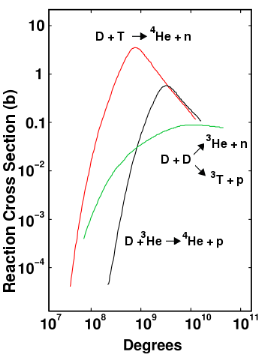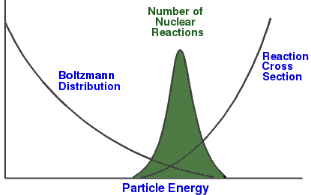science commentary
 ast week Lockheed Martin caused great excitement in the press by announcing
plans to build a small fusion reactor. Many people are calling it a “breakthrough.”
But Lockheed Martin is known for aerospace research and radar, not particle physics (unless
those rumors about Area 51 are really true). So what does this announcement really mean?
ast week Lockheed Martin caused great excitement in the press by announcing
plans to build a small fusion reactor. Many people are calling it a “breakthrough.”
But Lockheed Martin is known for aerospace research and radar, not particle physics (unless
those rumors about Area 51 are really true). So what does this announcement really mean?
Anyone doing research in industry will tell you the same thing: even if your
idea has a very, very low chance of success, if management is any good they
never say no. But they might tell you there are no funds for it.
Lockheed Martin's management probably told them: if you want to do this project,
go find some outside funding. Hence the carefully crafted announcement, with
beautiful pictures of brand new (and apparently never used) equipment. The
company turned it into a spectacular public relations announcement. But ten
years is a short time. If the scientists don't deliver, they will probably
have to finish the project on their own.
 Fig. 1. Fusion cross section versus temperature.
D = deuterium (2H), T = tritium (3H), p = proton, n = neutron,
He = helium.
(Redrawn from [1]).
Fig. 1. Fusion cross section versus temperature.
D = deuterium (2H), T = tritium (3H), p = proton, n = neutron,
He = helium.
(Redrawn from [1]).
The challenge they will face is that the plasma must be heated to 100,000,000 degrees—seven times the temperature in the core of the sun. Why so hot? It turns out the sun is too cold to do fusion very efficiently. The energy it produces is roughly equivalent to one candle per cubic meter. The sun is big, so it adds up. Stars could, of course, create energy much faster, but their lifetime is much shorter when they do.
The three nuclear reactions that are the most practical are shown in Fig. 1.
The easiest one is
D + T → 4He + n (called D-T for short) because
it works at a lower temperature than the others, and
the reaction cross section is reasonably high.
Cross section is a very important concept, so I will explain
it in detail. It's a measure of how much reaction takes place for a given quantity
of particles. It is used in the equation
Wr = σr J N
where
Wr is the rate at which the reaction occurs,
σr is the cross section, J is the
particle flux,
and N is the number of particles. So to get a good reaction, you
need a high density and a lot of energy. The units of cross section are barns,
as in “hitting the broad side of,” and it has units of area.
Saying a reaction has a high cross section is a shorthand way of saying
it works well if the conditions are suitable.
Astrophysicists use cross section to figure out what happens inside a star. Even at
a fixed temperature, such as at the core of a star, the particles don't all have
the same energy. They follow a curve called a Boltzmann distribution. In a typical
star, only an infinitesimal fraction of the particles have enough energy to fuse.
The most important reaction in stars is fusion of two protons to give deuterium,
a positron (or anti-electron), and a neutrino:
1H + 1H → 2H + e+ + νe
But even at 100 million degrees only 1 in 1055 hydrogen ions have enough
energy for this reaction to occur. In the Sun, where
the core temperature is a chilly 14 million degrees, the number is many orders
of magnitude less—about 1 in 10398.
Even worse, two protons are going in but a deuterium (which has one proton and one neutron) is coming out. So one of the protons has to turn into a neutron for this reaction to work. This means the cross section of this reaction is very small; the average proton takes 14 billion years to react. But once it does, it undergoes the next reaction, fusion to 3He, in only 6 seconds.
 Fig. 2.
Gamow window is the Gaussian-shaped area shown in green. In the Sun this
window is very small. (Redrawn from [1]).
Fig. 2 shows how this works. The green area is called the Gamow window. Only
particles in the area where the two curves overlap can undergo fusion. This means
that the rate of fusion in a star would vary enormously if its temperature changed.
However, if the temperature is too high, the reaction starts going in reverse—breaking
helium down into protons and neutrons. This is called photodisintegration
and it's what happens in a supernova explosion.
Fig. 2.
Gamow window is the Gaussian-shaped area shown in green. In the Sun this
window is very small. (Redrawn from [1]).
Fig. 2 shows how this works. The green area is called the Gamow window. Only
particles in the area where the two curves overlap can undergo fusion. This means
that the rate of fusion in a star would vary enormously if its temperature changed.
However, if the temperature is too high, the reaction starts going in reverse—breaking
helium down into protons and neutrons. This is called photodisintegration
and it's what happens in a supernova explosion.
Fusion also produces lots of neutrinos. In fact, about 99% of the energy emitted in a supernova is in the form of neutrinos, and scientists used neutrino measurements to estimate the temperature of a supernova as around 50 billion (5×1010) degrees [2]. Needless to say, there's no chance Lockheed Martin's reactor will ever get that hot.
What Lockheed has to do is make this Gamow peak as big as possible by moving those two curves closer together. They've already picked the easiest nuclear reaction. So they must move the Boltzmann distribution curve to the right by using a higher temperature.
That won't be easy. Fusion has been achieved many times with inertial confinement reactors, where the particles (which are in small pellets) are blasted by a pulse of light or electrons. The pulse is too brief for them to fly away, and their own inertia keeps them confined.
About 80% of the energy in the D-T reaction comes out as kinetic energy in 14 MeV neutrons. Many designs use lithium to absorb these neutrons and remove the heat. Molten lithium is a good coolant, and the reaction with neutrons produces more tritium, which can be recycled as fuel. But it's difficult to shield the reactor walls from the neutrons that are produced and to extract the energy efficiently, so the reactor always has to be stopped after a few seconds to clean it up.
Another problem is that the lithium process doesn't regenerate enough tritium, so new tritium has to be constantly supplied. Thus, the D-D reaction, which produces tritium directly, is what is really needed. Unfurtunately, D-D fusion requires 10-fold higher temperatures. Regardless of which reaction they use, the amount of tritium they'll be using is 1000 times more than is produced in fission reactors, and handling it safely will be tricky.
Lockheed is proposing a small magnetic confinement reactor. The challenges here will be astronomical. It will be very difficult to keep the beam hot in such close proximity to the magnets without losing the superconductivity. Immense amounts of heat will be caused by the particles, and by radiation that's produced by the particles as they move around in the magnetic field. This will be deposited in the walls as heat. Can Lockheed pull it off? I am skeptical. But a skeptic only needs to be proved wrong once. For once, I would love to be proven wrong.
References
[1] Choppin, Liljenzin and Rydberg, Radiochemistry and Nuclear Chemistry, 3rd ed.
Butterworth-Heinemann 2002.
[2] Boyd RN, An Introduction to Nuclear Astrophysics. Chicago, 2007.
